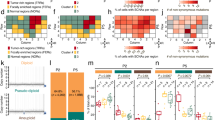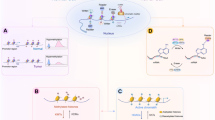Abstract
We reported previously that the loss of expression of estrogen receptor (ER)-β during the development of prostate cancer (PCa) is associated with methylation of a CpG island located in the 5′-flanking sequence of the 0N promoter. Three methylation hotspots, referred to as centers 1, 2 and 3, were identified in the CpG island. In this study, we demonstrated that a 581-bp region with these three centers within it is sufficient for the promoter activity in PCa cells. Deletion analyses indicated that center 1 (16 bp), with a putative activator protein-2 (AP-2) binding site, is essential for gene transactivation. Chromatin immunoprecipitation assays showed that AP-2α occupies a short sequence containing center 1. Forced expression of AP-2α or -2γ, but not -2β, increased activity of the ERβ 0N promoter and the accumulation of mRNA. Conversely, siRNA-mediated AP-2α and -2γ knockdown reduced levels of ERβ transcript and promoter activity. Quantitative reverse transcription–PCR showed that AP-2α and -2γ are the predominant transcripts expressed in PCa cells, and levels of ERβ transcript correlate with levels of these AP-2 transcripts among different PCa cell lines. These results provide the first evidence that ERβ is an AP-2-regulated gene. They also support the hypothesis that certain cis-acting elements are methylation hotspots susceptible to epigenetic modifications during cancer progression.
This is a preview of subscription content, access via your institution
Access options
Subscribe to this journal
Receive 50 print issues and online access
$259.00 per year
only $5.18 per issue
Buy this article
- Purchase on Springer Link
- Instant access to full article PDF
Prices may be subject to local taxes which are calculated during checkout





Similar content being viewed by others
Accession codes
References
Bar-Eli M . (2001). Gene regulation in melanoma progression by the ap-2 transcription factor. Pigment Cell Res 14: 78–85.
Baylin SB . (2005). DNA methylation and gene silencing in cancer. Nat Clin Pract Oncol 2 (Suppl 1): S4–S11.
Bosher JM, Totty NF, Hsuan JJ, Williams T, Hurst HC . (1996). A family of AP-2 proteins regulates c-erbB-2 expression in mammary carcinoma. Oncogene 13: 1701–1707.
Carroll JS, Meyer CA, Song J, Li W, Geistlinger TR, Eeckhoute J et al. (2006). Genome-wide analysis of estrogen receptor binding sites. Nat Genet 38: 1289–1297.
Comhaire F, Mahmoud A . (2004). Preventing diseases of the prostate in the elderly using hormones and nutriceuticals. Aging Male 7: 155–169.
Garinis GA, Patrinos GP, Spanakis NE, Menounos PG . (2002). DNA hypermethylation: when tumour suppressor genes go silent. Hum Genet 111: 115–127.
Hermann R, Doerfler W . (1991). Interference with protein binding at AP2 sites by sequence-specific methylation in the late E2A promoter of adenovirus type 2 DNA. FEBS Lett 281: 191–195.
Hilger-Eversheim K, Moser M, Schorle H, Buettner R . (2000). Regulatory roles of AP-2 transcription factors in vertebrate development, apoptosis and cell-cycle control. Gene 260: 1–12.
Hirata S, Shoda T, Kato J, Hoshi K . (2001). The multiple untranslated first exons system of the human estrogen receptor beta (ER beta) gene. J Steroid Biochem Mol Biol 78: 33–40.
Ho SM, Leung YK, Chung I . (2006a). Estrogens and antiestrogens as etiological factors and therapeutics for prostate cancer. Ann NY Acad Sci 1089: 177–193.
Ho SM, Tang WY, Belmonte DF, Prins GS . (2006b). Developmental exposure to estradiol and bisphenol A increases susceptibility to prostate carcinogenesis and epigenetically regulates phosphodiesterase type 4 variant 4. Cancer Res 66: 5624–5632.
Horvath LG, Henshall SM, Lee CS, Head DR, Quinn DI, Makela S et al. (2001). Frequent loss of estrogen receptor-beta expression in prostate cancer. Cancer Res 61: 5331–5335.
Imamov O, Shim GJ, Warner M, Gustafsson JA . (2005). Estrogen receptor beta in health and disease. Biol Reprod 73: 866–871.
Kuiper GG, Enmark E, Pelto-Huikko M, Nilsson S, Gustafsson JA . (1996). Cloning of a novel receptor expressed in rat prostate and ovary. Proc Natl Acad Sci USA 93: 5925–5930.
Lai JS, Brown LG, True LD, Hawley SJ, Etzioni RB, Higano CS et al. (2004). Metastases of prostate cancer express estrogen receptor-beta. Urology 64: 814–820.
Lau KM, LaSpina M, Long J, Ho SM . (2000). Expression of estrogen receptor (ER)-alpha and ER-beta in normal and malignant prostatic epithelial cells: regulation by methylation and involvement in growth regulation. Cancer Res 60: 3175–3182.
Leav I, Lau KM, Adams JY, McNeal JE, Taplin ME, Wang J et al. (2001). Comparative studies of the estrogen receptors beta and alpha and the androgen receptor in normal human prostate glands, dysplasia, and in primary and metastatic carcinoma. Am J Pathol 159: 79–92.
Livak KJ, Schmittgen TD . (2001). Analysis of relative gene expression data using real-time quantitative PCR and the 2(−delta delta C(T)) method. Methods 25: 402–408.
Marreiros A, Dudgeon K, Dao V, Grimm MO, Czolij R, Crossley M et al. (2005). KAI1 promoter activity is dependent on p53, junB and AP2: evidence for a possible mechanism underlying loss of KAI1 expression in cancer cells. Oncogene 24: 637–649.
Mitchell DC, Abdelrahim M, Weng J, Stafford LJ, Safe S, Bar-Eli M et al. (2006). Regulation of KiSS-1 metastasis suppressor gene expression in breast cancer cells by direct interaction of transcription factors activator protein-2{alpha} and specificity protein-1. J Biol Chem 281: 51–58.
Mohibullah N, Donner A, Ippolito JA, Williams T . (1999). SELEX and missing phosphate contact analyses reveal flexibility within the AP-2[alpha] protein: DNA binding complex. Nucleic Acids Res 27: 2760–2769.
Nieto M, Finn S, Loda M, Hahn WC . (2007). Prostate cancer: Re-focusing on androgen receptor signaling. Int J Biochem Cell Biol. doi: 10.1016/j.biocel.2007.01.005.
Ockrim J, Lalani E, Abel P . (2006). Therapy Insight: parenteral estrogen treatment for prostate cancer – a new dawn for an old therapy. Nat Clin Pract Oncol 3: 552–563.
Pellikainen JM, Kosma VM . (2007). Activator protein-2 in carcinogenesis with a special reference to breast cancer-A mini review. Int J Cancer 120: 2061–2067.
Ruiz M, Troncoso P, Bruns C, Bar-Eli M . (2001). Activator protein 2{alpha} transcription factor expression is associated with luminal differentiation and is lost in prostate cancer. Clin Cancer Res 7: 4086–4095.
Shoda T, Hirata S, Kato J, Hoshi K . (2002). Cloning of the novel isoform of the estrogen receptor beta cDNA (ERbeta isoform M cDNA) from the human testicular cDNA library. J Steroid Biochem Mol Biol 82: 201–208.
Signoretti S, Loda M . (2001). Estrogen receptor beta in prostate cancer: brake pedal or accelerator? Am J Pathol 159: 13–16.
Tummala R, Romano RA, Fuchs E, Sinha S . (2003). Molecular cloning and characterization of AP-2 epsilon, a fifth member of the AP-2 family. Gene 321: 93–102.
Zhu CH, Huang Y, Oberley LW, Domann FE . (2001). A family of AP-2 proteins down-regulate manganese superoxide dismutase expression. J Biol Chem 276: 14407–14413.
Zhu X, Leav I, Leung YK, Wu M, Liu Q, Gao Y et al. (2004). Dynamic regulation of estrogen receptor-β expression by DNA methylation during prostate cancer development and metastasis. Am J Pathol 546: 17–24.
Acknowledgements
We thank Dr Frederick E Domann for providing AP-2 expression plasmids. This work was supported in part by grants from the National Institutes of Health (DK061084 to SM Ho) and the Department of Defense (DAMD-W81XWH-04-1-0165 to SM Ho and W81XWH-06-1-0376 to X Zhang). Part of the work was conducted in the Department of Surgery, University of Massachusetts Medical School, Worcester, MA 01605, USA.
Author information
Authors and Affiliations
Corresponding author
Rights and permissions
About this article
Cite this article
Zhang, X., Leung, YK. & Ho, SM. AP-2 regulates the transcription of estrogen receptor (ER)-β by acting through a methylation hotspot of the 0N promoter in prostate cancer cells. Oncogene 26, 7346–7354 (2007). https://doi.org/10.1038/sj.onc.1210537
Received:
Revised:
Accepted:
Published:
Issue Date:
DOI: https://doi.org/10.1038/sj.onc.1210537
Keywords
This article is cited by
-
Estrogen receptor expression and gene promoter methylation in non-small cell lung cancer - a short report
Cellular Oncology (2016)
-
Potential clinical significance of ERβ ON promoter methylation in sporadic breast cancer
Medical Oncology (2013)
-
AP2γ regulates neural and epidermal development downstream of the BMP pathway at early stages of ectodermal patterning
Cell Research (2012)
-
Systematic identification of conserved motif modules in the human genome
BMC Genomics (2010)
-
AP-2α gene transfection effects cell proliferation and cell apoptosis of SW620 cells line in colorectal carcinoma
The Chinese-German Journal of Clinical Oncology (2010)



